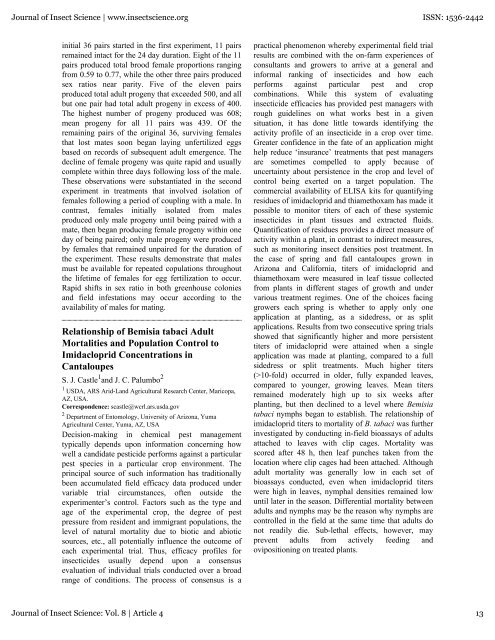Fourth International Bemisia Workshop International Whitefly ...
Fourth International Bemisia Workshop International Whitefly ...
Fourth International Bemisia Workshop International Whitefly ...
Create successful ePaper yourself
Turn your PDF publications into a flip-book with our unique Google optimized e-Paper software.
Journal of Insect Science | www.insectscience.org ISSN: 1536-2442<br />
initial 36 pairs started in the first experiment, 11 pairs<br />
remained intact for the 24 day duration. Eight of the 11<br />
pairs produced total brood female proportions ranging<br />
from 0.59 to 0.77, while the other three pairs produced<br />
sex ratios near parity. Five of the eleven pairs<br />
produced total adult progeny that exceeded 500, and all<br />
but one pair had total adult progeny in excess of 400.<br />
The highest number of progeny produced was 608;<br />
mean progeny for all 11 pairs was 439. Of the<br />
remaining pairs of the original 36, surviving females<br />
that lost mates soon began laying unfertilized eggs<br />
based on records of subsequent adult emergence. The<br />
decline of female progeny was quite rapid and usually<br />
complete within three days following loss of the male.<br />
These observations were substantiated in the second<br />
experiment in treatments that involved isolation of<br />
females following a period of coupling with a male. In<br />
contrast, females initially isolated from males<br />
produced only male progeny until being paired with a<br />
mate, then began producing female progeny within one<br />
day of being paired; only male progeny were produced<br />
by females that remained unpaired for the duration of<br />
the experiment. These results demonstrate that males<br />
must be available for repeated copulations throughout<br />
the lifetime of females for egg fertilization to occur.<br />
Rapid shifts in sex ratio in both greenhouse colonies<br />
and field infestations may occur according to the<br />
availability of males for mating.<br />
Relationship of <strong>Bemisia</strong> tabaci Adult<br />
Mortalities and Population Control to<br />
Imidacloprid Concentrations in<br />
Cantaloupes<br />
S. J. Castle 1 and J. C. Palumbo 2<br />
1 USDA, ARS Arid-Land Agricultural Research Center, Maricopa,<br />
AZ, USA.<br />
Correspondence: scastle@wcrl.ars.usda.gov<br />
2 Department of Entomology, University of Arizona, Yuma<br />
Agricultural Center, Yuma, AZ, USA<br />
Decision-making in chemical pest management<br />
typically depends upon information concerning how<br />
well a candidate pesticide performs against a particular<br />
pest species in a particular crop environment. The<br />
principal source of such information has traditionally<br />
been accumulated field efficacy data produced under<br />
variable trial circumstances, often outside the<br />
experimenter’s control. Factors such as the type and<br />
age of the experimental crop, the degree of pest<br />
pressure from resident and immigrant populations, the<br />
level of natural mortality due to biotic and abiotic<br />
sources, etc., all potentially influence the outcome of<br />
each experimental trial. Thus, efficacy profiles for<br />
insecticides usually depend upon a consensus<br />
evaluation of individual trials conducted over a broad<br />
range of conditions. The process of consensus is a<br />
practical phenomenon whereby experimental field trial<br />
results are combined with the on-farm experiences of<br />
consultants and growers to arrive at a general and<br />
informal ranking of insecticides and how each<br />
performs against particular pest and crop<br />
combinations. While this system of evaluating<br />
insecticide efficacies has provided pest managers with<br />
rough guidelines on what works best in a given<br />
situation, it has done little towards identifying the<br />
activity profile of an insecticide in a crop over time.<br />
Greater confidence in the fate of an application might<br />
help reduce ‘insurance’ treatments that pest managers<br />
are sometimes compelled to apply because of<br />
uncertainty about persistence in the crop and level of<br />
control being exerted on a target population. The<br />
commercial availability of ELISA kits for quantifying<br />
residues of imidacloprid and thiamethoxam has made it<br />
possible to monitor titers of each of these systemic<br />
insecticides in plant tissues and extracted fluids.<br />
Quantification of residues provides a direct measure of<br />
activity within a plant, in contrast to indirect measures,<br />
such as monitoring insect densities post treatment. In<br />
the case of spring and fall cantaloupes grown in<br />
Arizona and California, titers of imidacloprid and<br />
thiamethoxam were measured in leaf tissue collected<br />
from plants in different stages of growth and under<br />
various treatment regimes. One of the choices facing<br />
growers each spring is whether to apply only one<br />
application at planting, as a sidedress, or as split<br />
applications. Results from two consecutive spring trials<br />
showed that significantly higher and more persistent<br />
titers of imidacloprid were attained when a single<br />
application was made at planting, compared to a full<br />
sidedress or split treatments. Much higher titers<br />
(>10-fold) occurred in older, fully expanded leaves,<br />
compared to younger, growing leaves. Mean titers<br />
remained moderately high up to six weeks after<br />
planting, but then declined to a level where <strong>Bemisia</strong><br />
tabaci nymphs began to establish. The relationship of<br />
imidacloprid titers to mortality of B. tabaci was further<br />
investigated by conducting in-field bioassays of adults<br />
attached to leaves with clip cages. Mortality was<br />
scored after 48 h, then leaf punches taken from the<br />
location where clip cages had been attached. Although<br />
adult mortality was generally low in each set of<br />
bioassays conducted, even when imidacloprid titers<br />
were high in leaves, nymphal densities remained low<br />
until later in the season. Differential mortality between<br />
adults and nymphs may be the reason why nymphs are<br />
controlled in the field at the same time that adults do<br />
not readily die. Sub-lethal effects, however, may<br />
prevent adults from actively feeding and<br />
ovipositioning on treated plants.<br />
Journal of Insect Science: Vol. 8 | Article 4 13
















